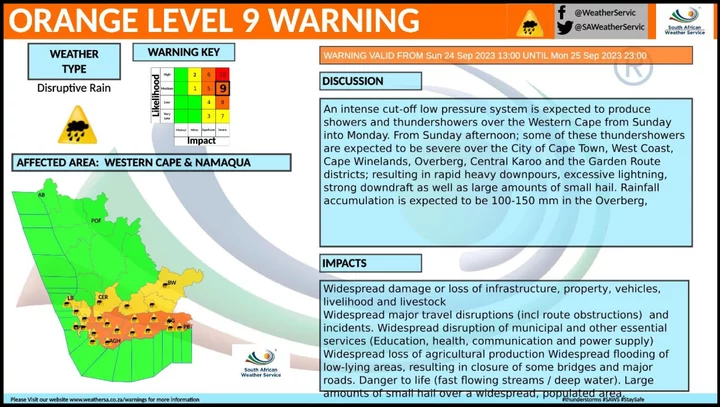Climate change intensified the torrential rain and flooding that’s swept South Africa’s Western Cape over the past two days, claiming at least 11 lives and forcing the evacuation of about 1,000 low-lying homes, the region’s top officials said.
The rains, which came just a week after larger-than-normal spring tides and earlier deluges, closed major routes into Cape Town, a coastal city of four million people, and damaged wheat crops, bridges and other infrastructure.
“The heavy rains are an indication of climate change, and while our early warning and mitigations systems did work, we have to keep investing,” Anton Bredell, the Western Cape’s provincial minister for local government and development planning, said Tuesday. “We will be having some very serious budget conversations going forward. Our climate strategy is working but it needs to step up.”
Eight of the 11 people who died were electrocuted in shanty towns when waters swamped illegal connections to the power lines. The flooding caused the closure of 84 roads.
“I don’t know if you could actually invest for a flood like this. It requires long-term planning. We have to make sure those plans start rolling out into the future,” said Alan Winde, the Western Cape’s premier. “This is probably a one-in-100-year flood once we work out how much water flowed through.”
Cape Town Mayor Geordin Hill-Lewis signed a major incident declaration, which allows for the unlocking of additional resources and relief measures to deal with impact of the floods, the city said in a statement on Tuesday.
Records Smashed
Over the 48 hours to 8 a.m. on Tuesday, 194 millimeters (7.65 inches) of rain fell in Stellenbosch, the heart of South Africa’s winelands, according to Christien Engelbecht, a meteorologist at the South African Weather Service.
In the small town of Elim, nearly 130 mm fell over 24 hours, quadrupling a 12-year record for September of 36 mm that fell around this time last year. Jonkershoek had 134 mm of rain, breaking a 1976 record of 85 mm for rain in September, which itself was the most in at least 64 years.
At two weather stations in Cape Town the rain was the highest for a day in September in at least 22 years, according to the Weather Service
The rain, which affected the Western Cape and parts of the neighboring Eastern Cape, was caused by a low-pressure weather system that causes heavy rain and isn’t unusual for this time of year.
The system prompted the South African Weather Service to issue a so-called Orange Level 9 Warnings for parts of the Western Cape for Sunday through Monday, forecasting “rapid heavy downpours, excessive lightning, strong downdraft as well as large amounts of small hail.” That’s the highest level warning ever issued for the Western Cape.
Losses and damages are still being calculated, and there is a possibility of a provincial disaster being declared, according to Bredell. President Cyril Ramaphosa offered the national government’s assistance, and the province is considering asking the army’s engineers to help it repair some of roads, he said.
The deluge follows storm damage along the Western Cape’s coast last weekend and floods in citrus farming areas in the province in June.
“This is an expensive winter,” Wouter Kriel, a spokesman for Bredell said by phone. The current focus is to get people off the roads and back into their houses, he said.
Adding to the national weather disaster costs are wildfires that have torched 1.8 million hectares (4.45 million acres) of grazing land across three provinces — North West, Free State and the Northern Cape — since the beginning of August. That’s led to the deaths of livestock, game and the destruction of infrastructure.
“I think the losses will be a lot more,” Christo van der Rheede, chief executive officer of AgriSA, a lobby group for South African farmers, said in an interview. “We will have to be more proactive to deal with fires and general disasters. Government and the private sector need to join hands as climate change increasingly has an impact on our lives.”
South Africa is increasingly being hit by climate disaster. In 2022 flooding in the eastern province of KwaZulu-Natal killed at least 435 people and in 2017 Cape Town almost ran out of water due to a severe drought.
The latest floods come after heavy rains in the North African country of Libya destroyed two dams earlier this month, killing 5,000 people and leaving at least 10,000 missing.
War and Aging Dams Left Libya Exposed to a Climate Superstorm
The latest extreme weather events illustrated why measures to mitigate against the effects of climate change had to instituted as a matter of urgency, said Salim Fakir, executive director of the African Climate Foundation.
The “government and the private sector must think and innovate around issues such as financing before and after a climate-related catastrophe” and build proactive resilience, he said. “The science of predicting climatic events is improving but it can’t predict the scale of the event.”
--With assistance from Mike Cohen.
(Updates with signing of relief measure in sixth paragraph)
Author: Paul Vecchiatto, Rene Vollgraaff and Antony Sguazzin

